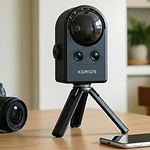
Modern VR systems like Oculus Quest or now also the Pico 4 are able to integrate hand tracking into their VR glasses. The user's hand movements and gestures are recorded with the help of infrared cameras and depth sensors and displayed in the virtual environment.
By using hand tracking, users can interact in VR environments without having to hold physical controllers. This improves immersion and the sense of presence in the virtual world. For example, users can grab, manipulate, or throw objects simply by moving their hands.
Hand tracking in VR also provides more opportunities for social interactions as users can use gestures and hand movements to communicate. In addition, hand tracking can also be used for various applications in education, medicine, and art.
However, there are also some challenges to implementing hand tracking in VR. Accurately capturing hand movements requires a sufficient amount of data, which means the need for powerful sensors and algorithms to process that data. In addition, computer learning of hand gestures and movements requires extensive data collection and processing to train the system.
Hand tracking is provided by Microsoft Hololens 2, HTC Vive XR Elite, Pico 4, Quest 2, Quest Pro, HMDs from Varjo and the Apple Vison Pro are supported.
Face tracking functions are available in some modern VR glasses and make it possible to track the user's facial movements and expressions in real time and project them onto an avatar. This means that the VR experience becomes much more realistic and immersive as the avatar of the wearer of the VR glasses mimics the facial expressions. The accuracy and reliability of the technology can vary depending on the manufacturer and model of the VR glasses.
Facetracking is used by HTC Vive XR Elite, Pico 4 Enterprise, Quest Pro and the Apple Vison Pro are supported.
Eye-tracking in VR is a technology that allows the VR system to track the movements of the user's eyes and use this information to enhance the VR experience. This technology is becoming increasingly popular in modern VR headsets and is expected to become a standard feature in the near future.
One of the main benefits of eye-tracking in VR is that it enables a more natural and intuitive user interface. Instead of relying on external controllers or gestures to interact with the virtual environment, users can simply look at objects to interact with them. This can make the VR experience more immersive and intuitive, especially for first-time users.
Eye tracking can also improve the graphics performance of VR applications. By tracking where the user is looking, the VR system can allocate more processing power to areas where the user is focusing, while reducing detail in areas where the user is not looking. This can result in more realistic and detailed graphics, as well as improved performance and reduced latency.
Another advantage of eye tracking in VR is that it can be used to gather valuable data about user behavior and preferences. For example, it can track which objects or areas of the virtual environment receive the most attention, which can help developers optimize the design of the VR experience for maximum engagement and impact.
Overall, eye-tracking is a powerful technology that can greatly enhance the VR experience by improving immersion, graphics performance, and user interface design. As VR technology continues to advance, it is likely that eye-tracking will become an increasingly important and widespread component of modern VR headsets. VR Bills like the Meta Quest Pro ud the Pico 4 Enterprise are already equipped with eye tracking.
Eyetracking is used by Microsoft Hololens 2, HTC Vive XR Elite, Pico 4 Enterprise, Quest Pro, HMDs from Varjo and the Apple Vison Pro are supported.







Hand tracking in VR enables users to interact in virtual environments without using physical controllers. Using infrared cameras and depth sensors, hand movements and gestures are captured and displayed in the virtual world. This improves immersion and the feeling of presence, as users can grab, manipulate or throw objects by simply moving their hands.
Facetracking captures the movements of the human face and enables facial expressions to be projected onto an avatar in real time. This makes the VR experience more realistic and immersive as the avatar mimics the user's facial expressions. Face tracking is used in VR, AR and computer vision to improve interaction with digital content.
Eye tracking in VR tracks the user's eye movements to enhance the VR experience. It enables a more natural user interface as users can simply look at objects to interact with them. In addition, eye tracking can optimize graphics performance by focusing processing power on the areas the user is looking at.
Accurate detection of hand movements requires powerful sensors and algorithms for data processing. The system must collect and process extensive data in order to correctly recognize hand gestures and movements. These requirements pose a challenge when implementing hand tracking in VR.
Face tracking is supported by VR glasses such as the HTC Vive XR Elite, Pico 4 Enterprise, Quest Pro and Apple Vision Pro. This technology enables the user's facial movements and expressions to be tracked in real time and projected onto an avatar.
Eye tracking offers several advantages for VR applications, including a more natural user interface and improved graphics performance. It allows users to interact with objects by simply looking at them and optimizes processing performance by focusing on the areas the user is looking at. It can also collect valuable data on user behavior and preferences.
Hand tracking is supported by VR systems such as the Microsoft Hololens 2, HTC Vive XR Elite, Pico 4, Quest 2, Quest Pro, HMDs from Varjo and the Apple Vision Pro. These systems integrate hand tracking into their VR glasses to enable improved interaction in virtual environments.